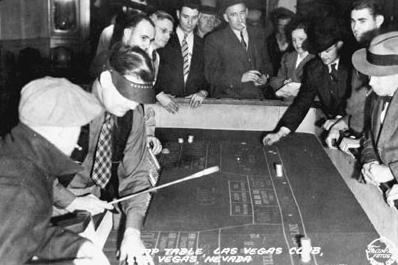Hazard
Hazard is an old English dice game that contains elements of today’s craps game. Knights played hazard as early as the twelfth century during the crusades to Arabia and the Middle East. It was not until the seventeenth and eighteenth centuries, however, that hazard became the most popular English casino game.
In basic hazard, a shooter throws two dice. He throws and rethrows until he gets a 5, 6, 7, 8, or 9. This number then becomes his “point.” He rolls again (and again), until a game-ending number comes up. He wins if he makes the point and also if he rolls an 11 or 12 (with some exceptions). He loses if he rolls a 2 or 3 (called a crabs). With a 4 or 10, he rolls again. If he rolls a 5, 6, 7, 8, or 9 that is not his point, it now becomes his “chance”, and he loses if he rolls it again (which means he rolls it before he rolls his point or a 2, 3, 11, or 12).
For a player making rolls over and over, the game was not difficult to understand, although it certainly seems to be a complicated game. To make matters more confusing, many variations were added to the game as time passed. When the game was brought to the North American colonies, the craps version was introduced, and this version was accepted as the standard two-dice game in North America. A three-dice game called grand hazard was also widely played in the colonies. The games of chuck-a-luck and sic bo became a variation of grand hazard.
Chuck-a-Luck
Chuck-a-luck is a three-dice game also known as “bird cage.” Three dice are placed into a large cage shaped like an hourglass. The cage is on an axis, and it is rotated several times by a dealer. The dice fall, and their numbers total from 3 to 18 (each die showing a 1 to 6). A player may bet that a certain number (1 to 6) will show on at least one die. If it does, he or she receives an even-money payoff; if the number appears on two dice, the payoff is two to one; if all three dice show the number, the payoff is three to one. Although the bet appears to most casual observers to favor the player, the house actually has a 7.87 percent advantage.

A game of craps in a Las Vegas casino, ca. 1940.

Chuck-a-luck is a three-dice game. Here it is played by the editor and David Nichols (in author biographies) at a charity casino event in El Paso, Texas.
Other bets could also be made. For instance, a player could wager that there would be a three of a kind on a particular number, or any three of a kind. A player could also bet on a high series of numbers or a low series of numbers.

Casino Craps layout. Many different bets are allowed in this most popular dice game.
Sic Bo and Cussec
Sic bo and cussec are two variations of chuck-a-luck. Sic bo is popular in Canada; cussec is played in many Asian countries, as well as in Portugal. Until 1999, no dice were allowed in Canadian games. Sic bo was played in some rather unique ways. A casino in Vancouver had players roll three small balls into a roulette wheel marked with the faces of two dice on each number area (thirty-six markings). At the charity casino in Winnipeg’s Convention Centre (open for a few years during the 1980s), there was an actual slot machine that had three reels. On each reel was the face of a die. The three die faces became the player’s “roll”.
French Bank
French bank is a very fast three-dice game played in Portugal. It is one of the most popular games in Portuguese casinos. The three dice are thrown rapidly until a low series (5, 6, or 7) or a high series (14, 15, or 16) comes up. Players wager even money on low or high. If three aces (1–1–1) come up, all players lose, except those betting on the three aces – they win a sixty-to-one payoff.
Backgammon
Backgammon is a game played with two dice and a board. It involves moving tiles around a playing surface and also blocking movements by one’s opponents. The game is considered by some to be the oldest board game, as it dates back to Roman times. In the eighteenth and nineteenth centuries, it was very popular with English nobility and involved very high gambling stakes.